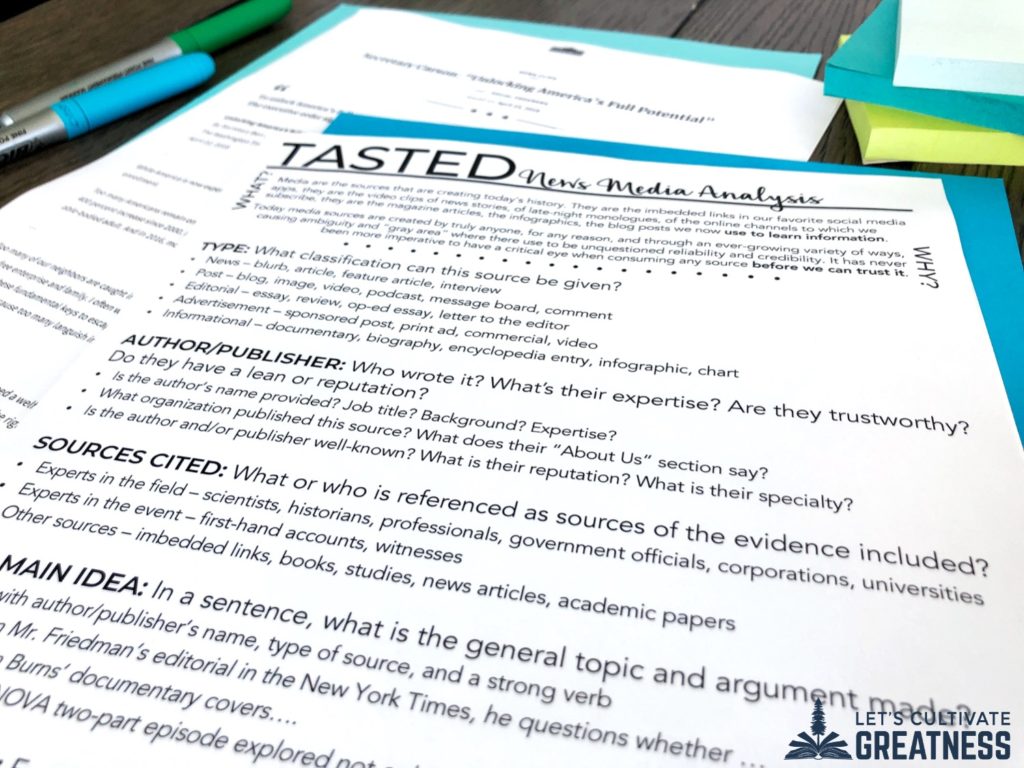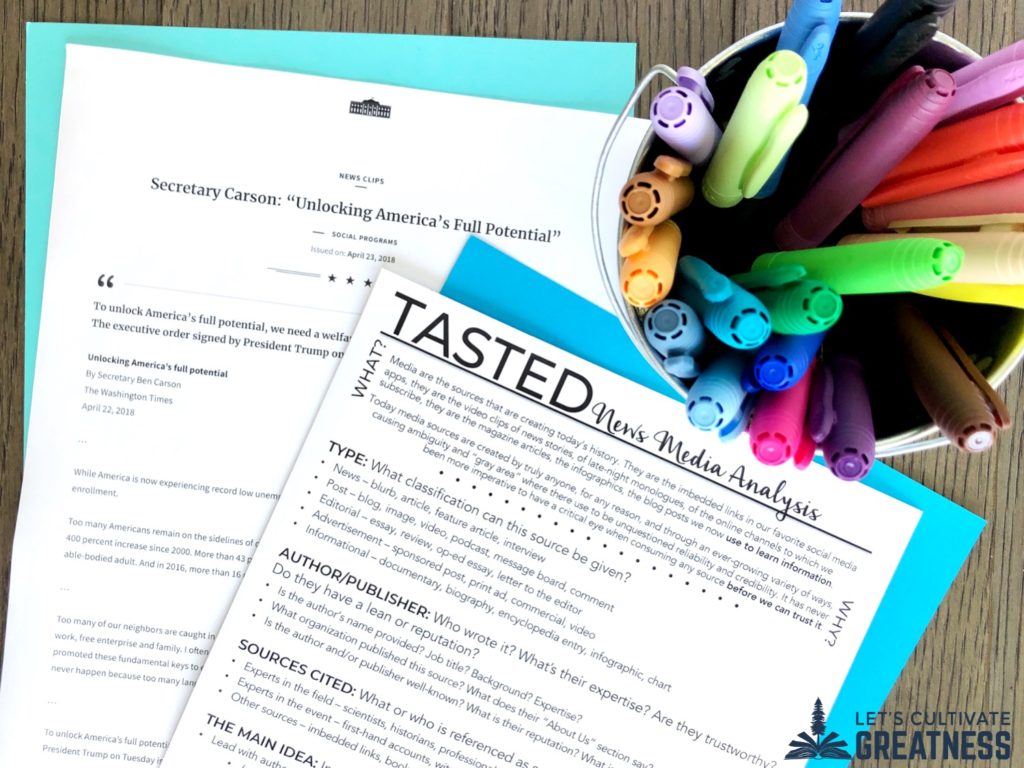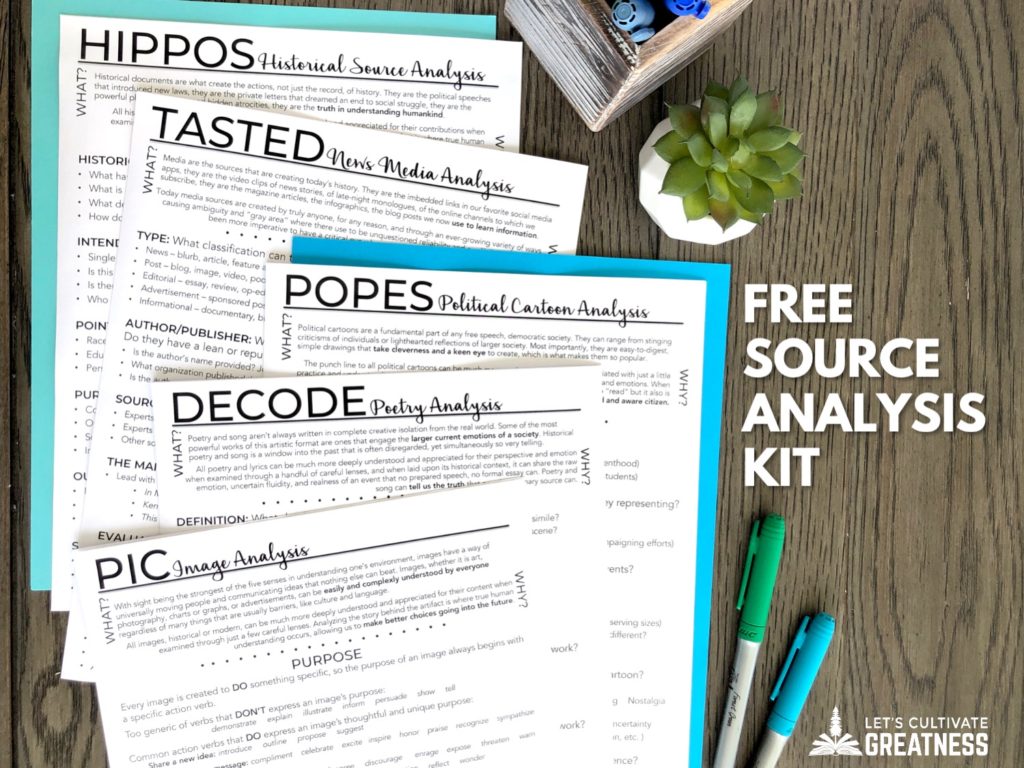The ability to assess news media effectively is perhaps THE most important 21st century critical thinking skill there is, especially since media now infiltrates all aspects of our lives and can be created by anyone. But where to even begin since there are so many types, from so many different publishers, and coming at us from so many directions?
Over the years, I have entirely stepped away from the textbook and instead created a curated collection of historical primary and contemporary news sources, utilizing a handful of easy-to-use primary source strategies that handle each of them specifically. One of which is the TASTED strategy for media sources, everything from news articles to editorials to blog posts. I love how it is flexible enough to work with any current media source!
Whether you are teaching history, geography, civics, or a social science course like sociology, including current events and real world sources is a no-brainer and a must for creating media-savvy young adults.

Scroll down to learn the TASTED method and to access your very own FREE TASTED News Media Analysis Skill Sheet along with 5 other primary source sheets to empower you to teach any primary source like a pro.
Or click below to download the pack now!
Before diving into the TASTED method, though, we need to set our students up for success.
1. Find good sources.
This really means two things: be sure to gather a variety of sources and also ensure they always have a valuable critical thinking take-away for your students. Knowing what your precise objective is for a lesson, first, helps significantly with this.
If my Civics students are researching an initiative on the upcoming ballot, then I want them to examine news articles from different newspapers. That way they can not only gather facts and arguments to help them decide which way to vote in their forthcoming mock election, but we can also assess the news articles for any bias.
If my US History students are learning about a group of people, say Vietnamese immigrants in the 1970s, then I want them evaluating the strengths and limitations of personal essays verses a 40th anniversary feature article in telling the story of their struggles and accomplishments. Both are useful to us, but neither can paint the full picture.
When you include media sources, having a secondary critical thinking task is a must! That added challenge is what will capture your students’ interest. That’s why textbooks are inherently boring—they take the critical thinking intrigue out of reading to learn.
2. Make clean copies.
Use a program like Print Friendly to make easy-to-read versions of your sources. This website transforms any webpage into a clean, ad-free, annotate-friendly file. You can even resize the text and images as well as select only the paragraphs you want to include. Then, just click “Save as a PDF” or “Print”! The best part is you don’t need a login and it’s totally free!
If at all possible, print sources for students to read and annotate by hand. Or place articles into sheet protectors for dry eraser annotating. If you can’t, then the PDF version works great, too, for digital annotating.
3. Predict students’ questions and misconceptions.
Spend a few minutes thinking about what prior knowledge students will need to know, or incoming misconceptions they will have either about the topic and/or the sources. Often when I do this I realize I need to do a quick fact-check or look up a question I have! Guessing what they may ask definitely gets easier with time.
4. Define any academic words.
Quality news organizations often have a solid high school reading level, giving your students the opportunity to see examples of academic language “in the wild,” but not to be so inundated with advanced language that it is impossible to comprehend the text.
As part of my lesson preparation, I skim through and identify those academic words and mark them by putting a box around them prior to making copies. Then, we crowdsource the task of defining these words together prior to reading.
5. Provide an annotating task.
This is where providing engaging contextualization prior to students reading the source is crucial. You not only are enticing your students to want to be on the hunt for content, but also looking for that secondary critical thinking component. Give a teaser for what they are about to explore. Pose a wondering or two. Leave a gap in knowledge that the source will answer.
Phrase your annotating task as a question, like: What words make this source biased? Are the author’s sources credible enough? What voice or side is missing from this source?
Now, you’re ready to use the TASTED strategy!

This is my go-to for any media in my classroom. Here are the basics of how it works:
Type
Is it an editorial? An in-depth feature article? A blog post? You get the idea.
Author / Publisher
Who is the author and/or publishing company? Can we trust them?
Sources Cited
What sources are mentioned in the source? Can we trust those?
The Main Idea
What is a sentence or two summary of the whole source?
Evaluation
Is this source worthwhile to what we are trying to learn? Is it credible?
Deficient
What aspects of this topic aren’t included? What keywords do we need to use to go find those missing pieces next?
The best part is how this framework builds students up to writing high-level annotations if the source will later become part of an annotated bibliography, which is exactly what they have to independently demonstrate in our end-of-course research projects.
I can’t recommend this strategy enough for exploring media sources with students!
Click below for your FREE download!

Feature image credit: Absolute Vision








